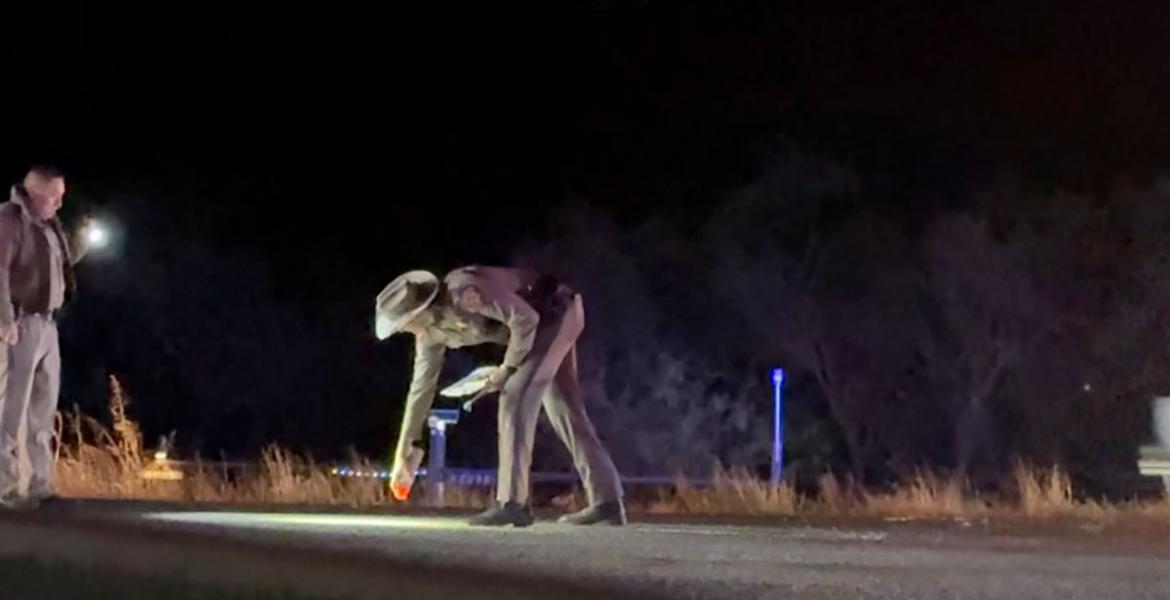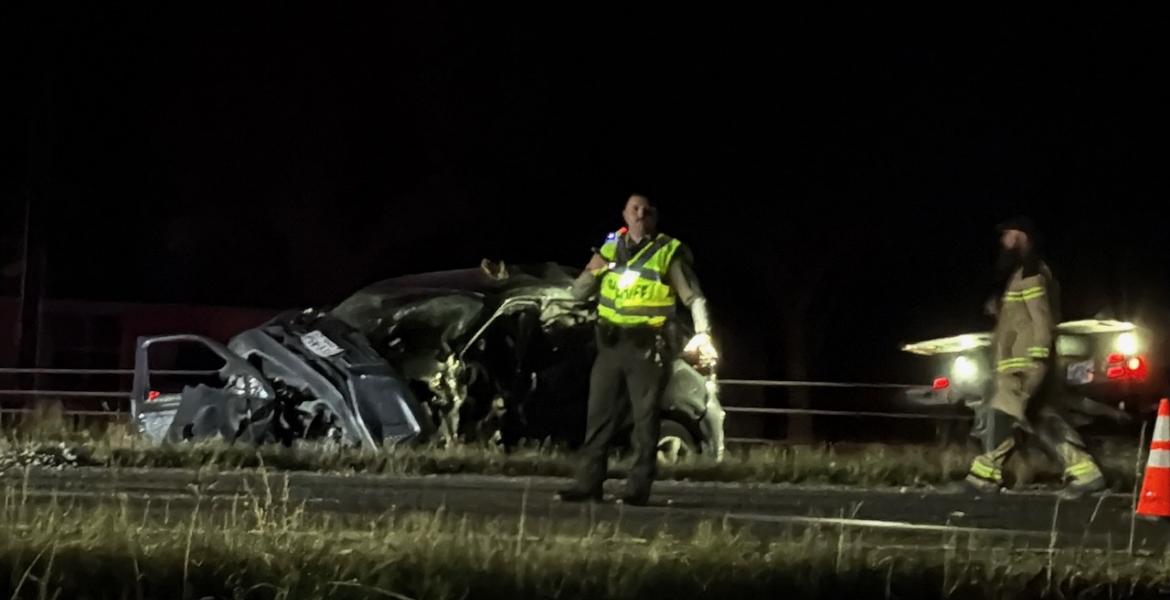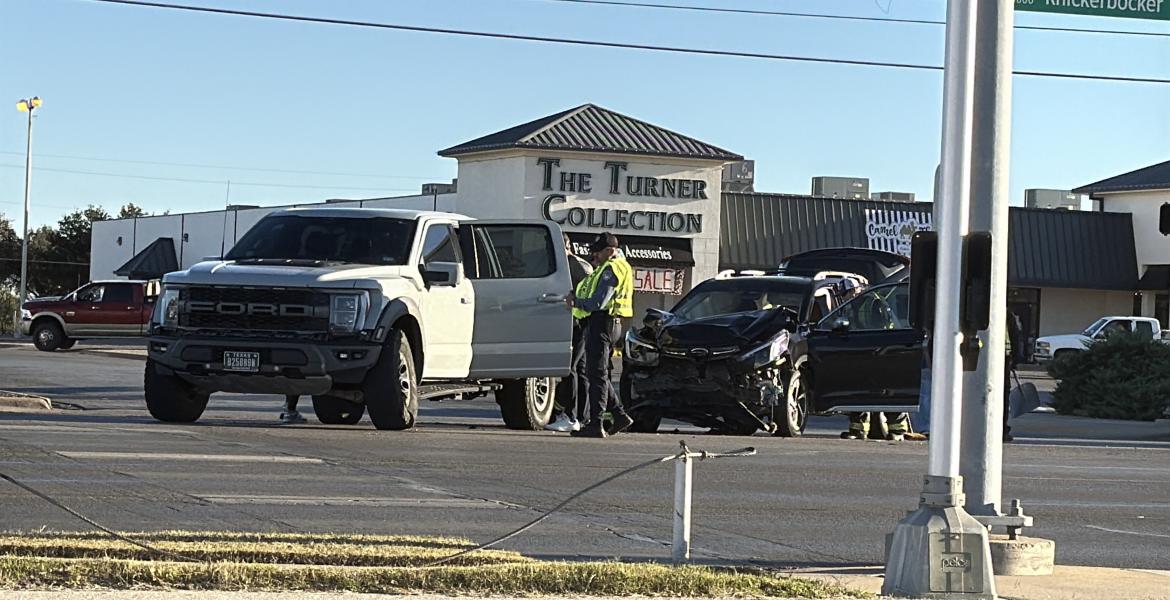Dozens of “people” were injured or killed by drunk drivers at the offices of Townsquare Media (KGKL-FM) on South Abe Street on Monday, as participant after participant put on varying strengths of beer goggles and wove their way through a cone-marked obstacle course in a golf cart.
The demonstration, put on by the Traffic Safety Coalition (TSC), offered sober attendees the opportunity to experience the walk from the bar to the car at varying levels of intoxication, and then attempt the drive home.
The course was marked off by closely-set orange road cones meant to represent people, and at the conclusion of the course Sheriff’s Deputy Ron Sanders conducted two field sobriety tests on each driver. At the end, not a single person passed the tests or the course, including one female who was wearing goggles set at 0.06 (below the legal limit), and one who drove without glasses but with her cell phone in hand.
Todd Deere, a Safety Specialist for TSC, said the coalition services 16 counties around San Angelo and holds demonstrations at various colleges and high schools throughout the year.
"What this does is demonstrate impaired driving at different levels,” Deere said. “When I got to the colleges and high schools, I have the kids put these on and drive with them and it lets them know with a sober mind and the goggles on what they’re really doing. If they’re already impaired, they don’t know what’s going on.”
Generally, when Deere holds a goggle demonstration, he says the participants respond a bit shocked, stating they didn’t realize that the level of impairment was that bad.
A participant in Tuesday’s demo, David Whitacre of Townsquare Media, had a difficult time with the course.
“I put on the goggles that were 0.20 intoxication [and] walked to the golf cart,” he said. “As soon as you put on the goggles everything’s distorted. Everything’s completely off; nothing is where it seems to be.”
Whitacre completed the course without the directional aid of the TxDOT workers, who had helped the others by calling them to the right or left. He tried to maintain a faster pace to more closely simulate a real driving experience.
“I hit 10 cones and actually completely missed a set of cones,” he said. “So, yeah, I failed miserably. We’ve had a range of 0.06 to 0.25 and everybody’s failed the course, so that just shows that no matter what level of impairment you had it’s not a very good thing to get behind that wheel.”
Stressing the importance of the exercise and what it’s meant to communicate, Deputy Sanders mentioned the tie between alcohol and death.
“We work too many crashes where alcohol causes fatalities…[this] gives you an idea to understand what we’re seeing,” Sanders said to a volunteer who had just completed a field sobriety test with goggles gauged at 0.12. “The sobriety test that you just did, you can’t do it…there’s no way in the world that you could have gotten in the car. That’s what we’re trying to sell.”
Referring to the crash that killed 20-year-old Aaron Allen on Dec. 6, San Angelo motor officer Bryan Bylsma added, “And on top of it, the fatality the other night, yeah, [alcohol] was a contributing factor. But while we were working that wreck, we had four police cars, an ambulance, ladder 1, all out in the intersection and this guy decided he wanted to make a left-hand turn in front of us. [He] almost hit one of our crime scene people.
“Well, he was drunk, he had an open container,” Bylsma said flatly. “They took him through the process, he was drunk and when he blew, he blew a 0.19. As many emergency vehicles as were in that scene, he still had the conscious effort of being able to say, ‘I need to go that way because I live that way’, instead of going straight.”
This year, wrecks are up by approximately 8 percent, Bylsma said. He explained that the contributing factors to most of the wrecks the police department handles are typically failure to control speed or unsafe speed. Lately, the common contributing factors to motorcycle crashes have been speed and alcohol use. Alcohol was a contributing factor in the last two fatality motorcycle wrecks in San Angelo this year.
In a recent traffic safety awareness survey conducted during the last week of July, TxDOT collected answers from some 2,245 participants statewide, including 111 from San Angelo.
The questions revolved around a couple of safety issues, including speeding, seat belts and impaired driving. Of those who responded, 11.59 percent said that they had driven within two hours of drinking alcoholic beverages, and 3.62 percent replied that they frequently drive after drinking more than they should have. Another 3.62 percent said they sometimes drive after drinking more than they should have and another 10.24 percent said they very rarely drive in those situations.
The most common response (10.56 percent) as to why people drive when they personally feel they’ve had too much to drink was “I was close to home”. Another 10.48 responded that they “Had no other way to get home” and 9.74 percent said “Thought I was ok/not drunk at the time.”
Although the legal measure for intoxication is having a blood alcohol concentration of 0.08 or more, officers point out that one does not have to blow 0.08 to be considered legally intoxicated.
“People that don’t drink, they don’t usually drink a drop of alcohol, well, during the holidays they go and they’re at their friend’s house or with their family members and they’re serving wine,” Sanders said. “They’ll have wine with dinner or some mixed drinks. They’ll maybe have one, two, up to three and their BAC level will be half the legal limit. But since they’re novice drinkers, they don’t drink throughout the year, they don’t have a tolerance for the alcohol, so they’re still going to be impaired.”
The law defines intoxication as either having a BAC of 0.08 or greater, or “not having the normal use of mental and physical faculties by reason of introduction of alcohol” and/or another controlled substance.
“That could be intoxication at 0.04, or half the legal limit,” Sanders explained. “If you’re impaired to the point that you cannot do [things], yes, you’re impaired to the point that you cannot drive. If you’re going to drink, we don’t mind that, just don’t drive.”
Recalling his experience both walking a straight line and holding his foot out while looking at it and counting during a field sobriety test, Whitacre said he had real difficulty with both tasks.
“The line was a complete arc,” he said. “He told me it was a straight line and I knew it was a straight line from seeing it before putting the glasses on, but when you’re looking at it with the glasses it’s completely curved. When you’re trying to walk that straight line you almost feel yourself trying to walk in an arc. I could feel myself falling both ways. I don’t even think I was on the line by the time I got back.”
The same was true for a female participant who had put on the goggles meant to simulate the depth perception and blurred vision of a person with a 0.06 BAC. It wasn’t surprising that she had failed both the driving and the field sobriety tests, officers explained, because they’d both encountered and arrested people for DWI who blew 0.04 in the breathalyzer test.
“Finding a designated driver is the most important thing because you’re protecting yourself and you’re protecting other people,” Deere said. “It’s not just your life at stake, it’s other people’s also. That has been seen in San Angelo several times, that a crash happens and an innocent victim gets killed or dies at the crash. It really needs to be a gift you’re giving by not drinking and driving home. Get a designated driver and give the gift of life.”
Subscribe to the LIVE! Daily
Required






Post a comment to this article here: